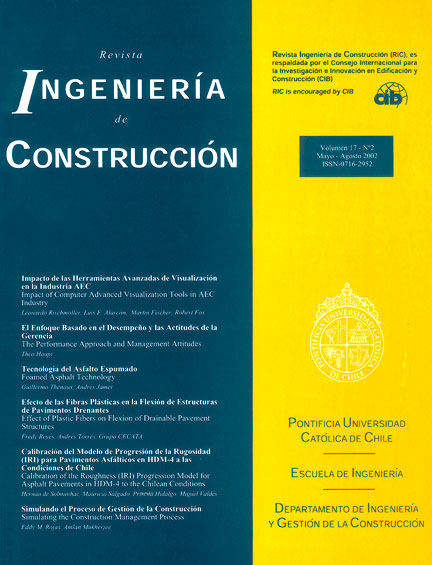Effect of plastic fibers on flexion of drainable pavement structures
Keywords:
Plastic wastes, porous concrete, resistance, design, modulus of elasticityAbstract
Water has always coexisted with concrete, either during the manufacturing process or when in use. One of the phenomena that is produced by the water has prompted this study. Under wet weather conditions, water cannot be adequately drained on a rigid pavement and it produces a film that creates an aquaplaning effect, seriously affecting the maneuverability of vehicles. Throughout the study, attempts are made to design a permeable rigid pavement by adding plastic wastes, based on the different investigations related to the topic, conducted in several countries and relying on different laboratory tests performed during the study, such as, for instance, simple compression, flexion, indirect traction and modulus of elasticity. In order to come up with the desired design, it was first necessary to adapt four mixture designs to a possible permeable design whose characteristics should resemble each of those described in the experiences obtained in previous investigations. Therefore, two tests were performed mainly for each of the designs, namely, simple compression and permeability and, on the basis of the results obtained, the one with the best performance was selected. After determining the optimum design, plastic strips having different sizes ( 2 mm by 10 mm and 4 mm by 20 mm) in different percentages (0.025%, 0.05%, 0.075%, 0.100%, 0.200%, 0.300%, 0.400% and 0.500%) were added and flexion, indirect traction and modulus of elasticity tests were performed, in order to obtain both the most suitable type of strip and the best percentage permitting a design for a fully permeable rigid pavement. Next, it was then compared to other pavements in what respects its behavior in the face of the different efforts. The different results obtained with the actual tests performed on the four preliminary designs, made it possible to determine that if a rigid pavement is to perfform as a permeable pavement, it must contain water to cement in a ratio in the order of 0.30 to 0.35, and some coarse crushed stones having no noticeable variations in size, in addition to a percentage of finer material lower than or equal to 15% of the total weight of the mixture. The results obtained with the tests performed on the best design by adding plastic strips of different sizes, made it possible to determine that the most suitable strip and the best percentage corresponds to the first strip (4 mm by 20 mm) added in 0.10%, as an increase is obtained for the best design with no plastic strips added of 3.4% for compression, 37.80% for flexion, 1.00% for indirect traction and 13.70% for modulus of elasticity. In like manner, a decrease of only 15.00% in flexion is obtained with a conventional concrete of f´c=420 kg/cm2 with K=2.65, even though porous concrete shows only f´c=240 kg/cm2 . Consequently, the main conclusion to be drawn from the study is that by adding waste plastic strips in a percentage of 0.10% with dimensions of 4 mm by 20 mm allows porous concrete to optimize its characteristics as to its behavior in the face of efforts, mainly flexion.


